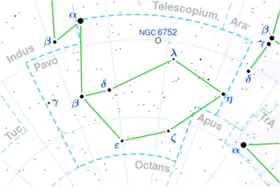Astronomy:Rho Pavonis
| Observation data Equinox J2000.0]] (ICRS) | |
|---|---|
| Constellation | Pavo |
| Right ascension | 20h 37m 35.31275s[1] |
| Declination | −61° 31′ 47.7145″[1] |
| Apparent magnitude (V) | 4.86[2] (4.85 – 4.91)[3] |
| Characteristics | |
| Spectral type | Fm δ Del[4] |
| U−B color index | +0.19[3] |
| B−V color index | +0.43[3] |
| Variable type | δ Sct[5] |
| Astrometry | |
| Radial velocity (Rv) | +8.0±0.8[2] km/s |
| Proper motion (μ) | RA: +59.61[1] mas/yr Dec.: −72.69[1] mas/yr |
| Parallax (π) | 17.20 ± 0.24[1] mas |
| Distance | 190 ± 3 ly (58.1 ± 0.8 pc) |
| Absolute magnitude (MV) | 1.04[6] |
| Details | |
| Radius | 4.33+0.39 −0.17[7] R☉ |
| Luminosity | 34.1±0.8[7] L☉ |
| Temperature | 6,704+136 −285[7] K |
| Rotational velocity (v sin i) | 45.0[8] km/s |
| Other designations | |
| Database references | |
| SIMBAD | data |
Rho Pavonis, Latinized from ρ Pavonis, is a single,[10] variable star in the southern constellation of Pavo. It is yellow-white in hue and faintly visible to the naked eye with an apparent visual magnitude that fluctuates around 4.86.[2] The star is located at a distance of approximately 190 light years from the Sun based on parallax,[1] and is drifting further away with a radial velocity of +8 km/s.[2] It is a candidate outlying member of the Tucana Association of co-moving stars.[11]
This is a metallic-line star with a stellar classification of Fm δ Del,[4] where the suffix notation indicating it is a δ Delphini star. It is a Delta Scuti variable, varying in brightness by 0.03 magnitudes.[13] The dominant pulsation period is 2.74 hours, but the effects of other pulsation periods are apparent in the light curve.[14] The star has 4.3[7] times the girth of the Sun and is spinning with a projected rotational velocity of 45 km/s.[8] It is radiating 34[7] times the luminosity of the Sun from its photosphere at an effective temperature of 6,704 K.[7]
References
- ↑ 1.0 1.1 1.2 1.3 1.4 1.5 van Leeuwen, F. (2007). "Validation of the new Hipparcos reduction". Astronomy and Astrophysics 474 (2): 653–664. doi:10.1051/0004-6361:20078357. Bibcode: 2007A&A...474..653V. Vizier catalog entry
- ↑ 2.0 2.1 2.2 2.3 Gontcharov, G. A. (November 2006). "Pulkovo Compilation of Radial Velocities for 35 495 Hipparcos stars in a common system". Astronomy Letters 32 (11): 759–771. doi:10.1134/S1063773706110065. Bibcode: 2006AstL...32..759G.
- ↑ 3.0 3.1 3.2 Garcia, J. R.; Cebral, J. R.; Scoccimarro, E. R.; Wahnon, P.; Arena, R.; Bazterra, V.; Pellizza, L.; Risi, A. et al. (1995). "A catalogue of variable stars in the lower instability strip". Astronomy and Astrophysics Supplement 109: 201. Bibcode: 1995A&AS..109..201G.
- ↑ 4.0 4.1 Houk, N.; Cowley, A. P. (1975), Michigan catalogue of two-dimensional spectral types for the HD stars. Declinations -90_ to -53_ƒ0, 1, Ann Arbor: Dept. of Astronomy, University of Michigan, Bibcode: 1975mcts.book.....H
- ↑ Samus, N. N. et al. (2009). "General Catalogue of Variable Stars (Samus+ 2007-2013)". VizieR On-Line Data Catalog: B/GCVS. Originally Published in: 2009yCat....102025S 1. Bibcode: 2009yCat....102025S.
- ↑ Anderson, E.; Francis, Ch. (May 2012). "XHIP: An extended hipparcos compilation". Astronomy Letters 38 (5): 331–346. doi:10.1134/S1063773712050015. Bibcode: 2012AstL...38..331A. Vizier catalog entry
- ↑ 7.0 7.1 7.2 7.3 7.4 7.5 Brown, A. G. A. (August 2018). "Gaia Data Release 2: Summary of the contents and survey properties". Astronomy & Astrophysics 616: A1. doi:10.1051/0004-6361/201833051. Bibcode: 2018A&A...616A...1G. Gaia DR2 record for this source at VizieR.
- ↑ 8.0 8.1 Głȩbocki, R.; Gnaciński, P. (March 2005), "Catalog of Stellar Rotational Velocities", VizieR On-Line Data Catalog: III/244. Originally Published in: Proceedings of the 13th Cambridge Workshop on Cool Stars, Stellar Systems and the Sun 3244, Bibcode: 2005yCat.3244....0G Vizier catalog entry
- ↑ "rho Pav". SIMBAD. Centre de données astronomiques de Strasbourg. http://simbad.u-strasbg.fr/simbad/sim-basic?Ident=rho+Pav.
- ↑ Eggleton, P. P.; Tokovinin, A. A. (September 2008). "A catalogue of multiplicity among bright stellar systems". Monthly Notices of the Royal Astronomical Society 389 (2): 869–879. doi:10.1111/j.1365-2966.2008.13596.x. Bibcode: 2008MNRAS.389..869E.
- ↑ Zuckerman, B. et al. (September 2001). "Tucana Association". The Astrophysical Journal 559 (1): 388–394. doi:10.1086/322305. Bibcode: 2001ApJ...559..388Z.
- ↑ "MAST: Barbara A. Mikulski Archive for Space Telescopes". Space Telescope Science Institute. https://mast.stsci.edu/portal/Mashup/Clients/Mast/Portal.html.
- ↑ Rodríguez, E. et al. (June 2000). "A revised catalogue of delta Sct stars". Astronomy and Astrophysics Supplement 144 (3): 469–474. doi:10.1051/aas:2000221. Bibcode: 2000A&AS..144..469R.
- ↑ Kurtz, D. W. (March 1981). "The δ Scuti variability of the high metallicity δ Del star, rho Pavonis". Monthly Notices of the Royal Astronomical Society 194: 737–746. doi:10.1093/mnras/194.3.737.
 |



